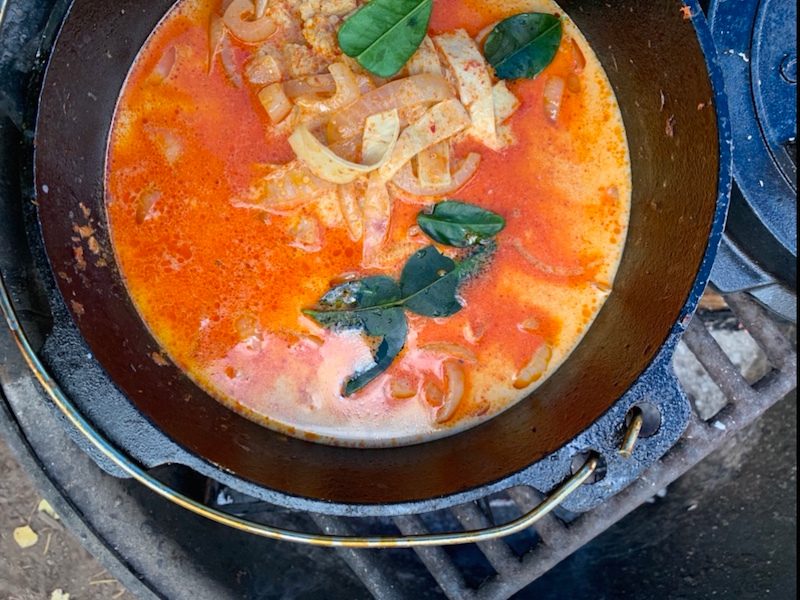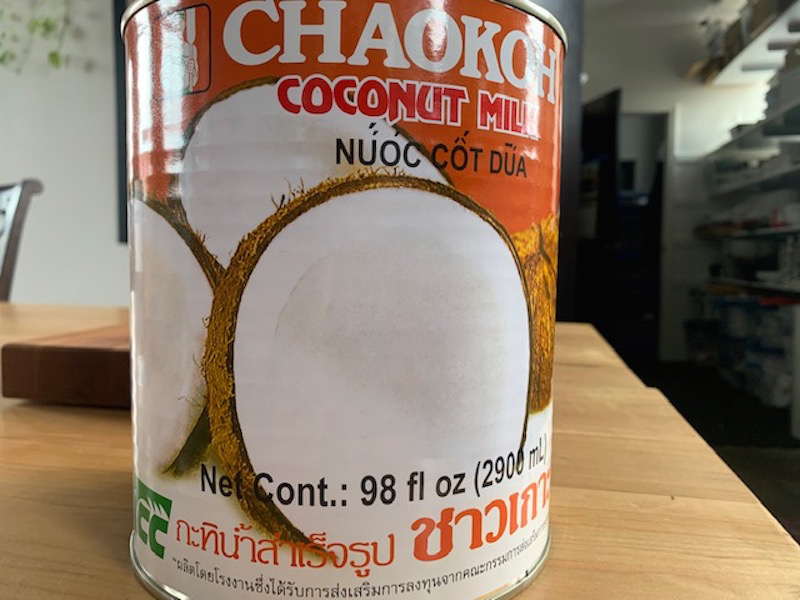PHOTOS BY CHANDRA WALBOLT
This column is underwritten with generous support from United Noodles, Minnesota’s largest Asian grocery store, awarded “Best International Grocery” by City Pages in 2014, 2016, and 2020. Chandra Walbolt is a professional chef with experience at several restaurants in the Twin Cities, and she currently serves as a manager at Union Hmong Kitchen. She will soon be the Executive Sous Chef at Yia Vang’s Vinai in Northeast Minneapolis.
Coconut plays such a large role in Southeast Asian food. One of the best snacks I had growing up was fresh young coconut. My mom would hand it to me with the top of the fruit cracked open carefully. I would drink the fresh coconut water within seconds and then quickly scrape the flesh out of the inside to munch on. Red curries were one of my favorite dinners, and coconut milk from a mature fruit is what made them so rich and creamy and just carried the flavor of chilies and lime leaf to coat the inside of my mouth so beautifully. And lastly… Naab Van. You take coconut milk or cream and sweeten it with lots of sugar, drop in tapioca pearls and ice! Melon is optional, but that’s how I like it. It’s the most refreshing and filling summer treat.
Coconut milk as we know it is man-made, although it can be made with all natural ingredients. (And here we’re talking about canned coconut milk and not the version that is typically used as a cow milk substitute. That variety is a bit more watery and may have a bunch of stabilizers.)
 When you open a can of coconut milk, more often than not you’ll find that the coconut liquid and the cream are separated. This is completely normal. Just stir until it’s emulsified or shake the can aggressively before opening.
When you open a can of coconut milk, more often than not you’ll find that the coconut liquid and the cream are separated. This is completely normal. Just stir until it’s emulsified or shake the can aggressively before opening.
Coconut cream (not to be confused with it’s sweetened cousin, cream of coconut) is also a canned variety of coconut that has a much higher coconut flesh to water ratio. This can be used as a substitute for coconut milk, just add a little water to thin it out.
Coconuts grow in tropical climates of Southeast Asia, and are grown on the largest scale in the Philippines and Indonesia. They grow on a species of palm trees that have root systems that prevent soil erosion and help reduce carbon dioxide in the air. These palms require minimal energy or fertilizer to grow.
Traditionally, to harvest coconuts, farmers use a long sturdy stick with a sharp hooked end. With this, they carefully reach to the top of the palm tree where the coconuts live and only chop down the hairy, brown mature ones. Mature coconuts are best for coconut milk and cream production, and boast the most fatty pulp. The coconut has 3 layers that get peeled pff. The hairy husk, hard shell, and then the hard brown skin before you get to the flesh.
To make coconut milk, the farmers grate the flesh and squeeze through a cheesecloth. This cream gets mixed 50% with water and that makes your coconut milk. For larger productions, the flesh gets blanched, making it softer for extraction, and strained with the water. This milk is then homogenized by pressure and heat treated for shelf stability. This version is what you’ll find at the store for the most part.
You can find coconut milk by the shelf stable canned goods at the Asian grocery or in the international section of your local grocery store. Brands that I like to use are Chaokoh, Aroy-D and Mae Ploy.
The way I frequently use coconut milk is for a basic red curry. It’s super easy, and at its base only requires a few ingredients. I personally like to add chicken thigh, bamboo, bell peppers, onions and a lot of Thai chilies. After you figure out the base of the broth, you can add anything you like.
A tip for a more flavorful broth is to saute your curry paste with ¼ of your coconut milk until thick and the curry paste is married into the reduced coconut milk. This will introduce your spices into a cooked down coconut milk so the flavor becomes more intensified.
 RED CURRY WITH CHICKEN THIGHS
RED CURRY WITH CHICKEN THIGHS
2 Tbsp neutral oil
2 Tbsp garlic, minced
1 4 oz. can red curry paste (I use Maesri or Mae Ploy brand)
1 13.5 fl oz. can coconut milk (I use Chaokoh)
2 cups broth (poultry or vegetable)
1 Tbsp fish sauce (optional, you can alternatively add salt to taste)
1 Tbsp sugar
1-2 makrut lime leaves
1 pound boneless skinless chicken thigh, cut to bite-sized pieces (optional)
In a medium-large pot, heat oil on medium-high and add garlic. Cook until fragrant but no color. Add curry paste and stir around until fragrant, about 1-2 minutes and then add about ¼ can of your coconut milk. Stir into the curry paste and let the milk reduce and marry into the paste. (there may be separation of coconut oil and cream, that is totally fine.)
Add the remainder of coconut milk and broth.
Mix in the fish sauce, sugar and lime leaf and bring to boil. Add chicken (or protein of choice), drop to a simmer and cover for at least 20 minutes or until your protein is fully cooked.
Eat on top or on the side of rice (I like my curry and rice separate but everyone is different!)

